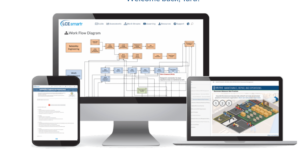LCE’s SEA Coaches to the Rescue
The mission of COMNAVAIRPAC (Commander Naval Air Force, U.S. Pacific Fleet) is to support the Pacific Fleet and Unified Commands by providing combat-ready Naval Aviation Forces which are trained, manned, interoperable, maintained and supported. This includes 79 squadrons operating 1,600 aircraft and six aircraft carriers.
Required Modifications to Machinery Control Systems Weren’t Functioning as Designed, Potentially Delaying a Ship’s Return to Service
The USS Nimitz (CVN 68) had been undergoing an extensive COMNAVAIRPAC-funded availability repair period which was rapidly approaching its final testing, sea trials and completion date. COMNAVAIRPAC awards contracts to external organizations known as Alteration Installation Teams (AITs) based upon bids submitted, which contain the organization’s proof it can successfully accomplish the scope of work.
For three months, an AIT worked on installing new, and modifying existing, Machinery Control System (MCS) Input / Output (IO) boxes to support the addition of numerous new (and removing a few legacy) Halocarbon monitoring alarm circuits. Halocarbon gas monitors are very important to ship and sailor safety because they detect high levels of refrigerant gases that can asphyxiate occupants of a confined space.
Once the installations and removals were completed, neither the AIT nor the shipyard’s planning, engineering and testing department could determine why the new MCS IO box installation would not communicate correctly on the network or why the newly installed Halocarbon alarm circuits would not function as designed.
A Lack of Expertise with Machinery Control Systems Prevented Completing the Necessary Updates
The shipyard’s planning and engineering department personnel didn’t have a detailed knowledge of the internal baseline MCS IO box construction or how its internal circuitry worked.
The contracted AIT had never performed the scope of work required to install new MCS IO boxes, alarm modules, harnesses or verification of a MCS IO box’s functionality. Additionally, the AIT’s lead installer was not trained on electronic equipment installation and testing or pulled fiber installation and testing.
The planning yard and AIT used a pre-existing, retired-in-place MCS IO box to save money and time. They assumed that all baseline IO box internal hardware components existed and functioned, and all internal baseline circuits functioned as designed. No preliminary inspection or testing was performed by either team to confirm both assumptions.
Enlisting the Help of an Experienced SEA Coach Results in Speedy Troubleshooting, a Functioning MCS and Enhanced Skills for the Ship’s Technicians
LCE provided a SEA Coach – a NSWCPD C519 MCS Networks Subject Matter Expert for both software installation/operation and hardware installation/operation – for a one-week onsite visit in the Bremerton shipyard onboard CVN 68. The tasking was to troubleshoot and repair the entire MCS Halocarbon installation.
The SEA Coach completed the task in one-third of the scheduled time, resulting in the AIT being able to report completion of the Ship Change Document (SCD). This led directly to the ship beginning Dock Trials, Fast Cruise and Sea Trials on schedule.
Not only did the SEA Coach resolve all installation and testing issues associated with this SCD within two days, he also identified, troubleshot and repaired four other MCS IO boxes which were exhibiting the same communication and alarm-circuit functionality problems. He also provided recommendations for all MCS-related items listed in the Current Ship’s Maintenance Project (CSMP) and reviewed the ship’s calibration report for MCS sensors, providing recommended actions to correct all deficiencies.
As an added benefit to the ship, the SEA Coach provided four days of on-the-job training to two CVN 68 technicians responsible for the MCS network. This enhanced their knowledge of troubleshooting techniques and MCS IO box modules, wiring harnesses and internal circuits.
About LCE
Life Cycle Engineering (LCE) provides consulting, engineering, information technology and education solutions that deliver lasting results for private industry, the Department of Defense and other government organizations. The quality, expertise and dedication of our employees enable Life Cycle Engineering to serve as a trusted resource that helps people and organizations to achieve their full potential. Founded in 1976, LCE is headquartered in Charleston, South Carolina with offices across North America and experience around the globe. Follow us on LinkedIn, Twitter and YouTube for company updates.

For more information on LCE’s SEA Coach Program,
please visit the Life Cycle Engineering website.
















